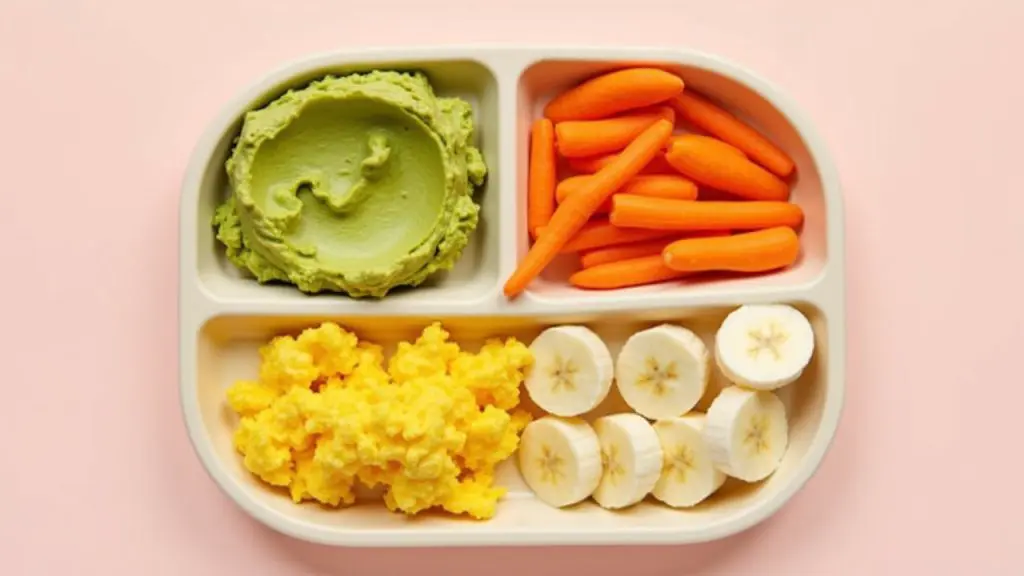Watching your baby go from bottles to bites is one of those big parenting milestones—it’s exciting, a little nerve-wracking, and often messier than expected. You might be wondering when to start, what foods to offer, how much is enough, and whether your baby will ever eat anything besides bananas.
Take a deep breath. You’re not alone. The transition to solid foods doesn’t have to be stressful. With a little patience, flexibility, and a whole lot of wipes, you can help your child make the shift from milk to meals with confidence (yours and theirs!).
This guide is packed with gentle, realistic tips to support you through every step of the journey—whether you’re just starting to introduce solids or navigating picky eating as things progress.
When to Start: Timing the Transition
Most babies are ready to begin the transition to solid foods around 6 months old, but that’s a general guideline. Some may show signs earlier, others a little later—and that’s okay.
Here are a few signs your baby may be ready to begin trying solids:
- They can sit up (with little or no support)
- They show interest in what you’re eating
- They’ve lost the tongue-thrust reflex (where they push food out automatically)
- They can hold their head up steadily
- They open their mouth when food comes their way
Starting solids too early can increase choking risks or lead to tummy troubles. Too late, and they might miss out on key nutrients like iron. Checking in with your pediatrician is always a good move if you’re unsure about the right time to begin the transition to solid foods.
Breastmilk or Formula Still Comes First
Even as you begin to introduce solids, your baby’s primary source of nutrition should still be breastmilk or formula for the first year. Think of solid foods at this stage as “practice”—not a replacement.
In the early days, your baby may only eat a spoonful or two at each attempt. That’s totally fine! The real focus is on learning how to chew, swallow, and explore different tastes and textures.
So during the transition to solid foods, milk is still the main event, and solids are more like a side dish. Eventually, that ratio will flip—but there’s no rush.
Purees vs. Baby-Led Weaning: Which Is Better?
There’s no one-size-fits-all approach to feeding. Some parents start with smooth purees, spoon-feeding one flavor at a time. Others opt for baby-led weaning, offering soft finger foods the baby can feed themselves.
Both approaches have their benefits:
- Purees allow for controlled texture and easier monitoring of food intake
- Baby-led weaning encourages independence and helps develop chewing skills early
You can also do a mix! There’s no rule that says you have to choose one or the other. The goal is to help your child become familiar with food in a way that feels safe and enjoyable. Whichever method helps your baby thrive is the right one for you.
As you go through the transition to solid foods, flexibility is your best friend.
First Foods to Try
Starting with iron-rich foods is a good idea, especially if your baby is around 6 months old. Some great options include:
- Mashed or pureed meats (chicken, beef, turkey)
- Iron-fortified baby cereals mixed with breastmilk or formula
- Cooked lentils or beans
- Mashed sweet potato, avocado, banana, or peas
- Soft scrambled egg or tofu
- Steamed veggie sticks (carrot, broccoli, zucchini) for baby-led weaning
Introduce one new food every 2–3 days so you can monitor for allergies or sensitivities. Keep portions small and allow your baby to lead the way.
Remember, the transition to solid foods is about discovery. It’s normal for your baby to make faces, spit things out, or reject certain flavors at first. Keep offering and stay positive—it often takes 10+ tries before a baby accepts a new food.

What About Allergens?
Research now shows that introducing common allergens like peanut butter, eggs, or dairy early and often (around 6 months) may actually help prevent food allergies—especially if there’s no family history of severe reactions.
When introducing these foods:
- Start small (like a tiny dab of peanut butter diluted in water or puree)
- Offer them in the morning so you can monitor for reactions during the day
- Only introduce one allergen at a time
Of course, always consult your pediatrician first, especially if allergies run in your family.
Safe and gradual exposure is a key part of a healthy transition to solid foods, and it sets the stage for a diverse and well-balanced diet later on.
Tips for Making Mealtime Easier
Let’s be real—feeding a baby can be fun, but also messy, unpredictable, and a bit of a power struggle some days. Here are a few parent-tested tips to help:
- Make it part of the routine: Offer solids at a consistent time each day, like after a nap or bottle when your baby is calm and alert.
- Let your baby lead: Don’t force bites. Offer the food and let them explore at their own pace—even if that means more playing than eating some days.
- Keep it low-pressure: Babies feed off your energy. Make mealtime fun, not stressful. Smiles and silliness go a long way.
- Expect a mess: Bibs, splash mats, and wipes are your best friends. Embrace the chaos—it’s part of the learning process.
- Eat together when possible: Babies love to mimic you. Sit down and eat with them whenever you can, even if it’s just for a few bites.
The more relaxed you are, the more relaxed your baby will be. That’s the secret sauce in a successful transition to solid foods.

Picky Eating: What’s Normal?
If your once-adventurous eater is suddenly refusing everything that’s not a cracker or a banana, take a deep breath—it’s totally normal. Picky eating is a common part of early childhood, especially during the toddler years. It’s not just about food preferences—it’s also about control, independence, and testing boundaries (which toddlers are very good at).
Your child might devour peas on Monday and then act like they’re poison on Tuesday. They might insist on eating the same meal for days on end and then abruptly decide they hate it. This back-and-forth is frustrating, yes, but it’s developmentally appropriate. During the transition to solid foods, toddlers are learning to listen to their own hunger cues and assert their likes and dislikes.
What can you do? First, know that it’s rarely about you or your cooking. Then try a few of these gentle strategies to keep things positive:
- Keep offering a variety without pressure
Don’t stop offering foods just because they were rejected once—or even five times. Research shows it can take 10 to 15 exposures for a toddler to accept a new food. Keep placing a small portion on their plate and let them choose whether to try it. - Make food fun
Presentation goes a long way. Use colorful plates, arrange food into shapes or smiley faces, and turn meals into little picnics or themed snack plates. The more playful and low-pressure the atmosphere, the more willing your toddler may be to explore what’s in front of them. - Let your toddler help
Involving kids in the kitchen gives them ownership over their meals. Let them stir, sprinkle, pour, or choose between two options. Even small tasks can make them more excited to try the final result. - Stick to regular mealtimes
Toddlers thrive on routine. Consistent mealtimes help regulate appetite and reduce random snacking that can interfere with meals. Try to avoid grazing throughout the day, which can lead to mealtime battles because they’re just not that hungry. - Limit snacks if they’re affecting appetite
Snacks are important, but they shouldn’t be a constant fallback. Keep snack times structured and avoid using snacks to distract or soothe boredom, which can create unhealthy habits down the road.
And here’s the golden rule: don’t stress. Picky eating is frustrating, but it’s rarely permanent. The key is to stay consistent, stay calm, and avoid turning meals into a power struggle. If your toddler refuses dinner, it’s okay—they won’t starve. Offer a balanced plate, let them decide what to eat, and move on without a big fuss.
The way you approach these moments matters more than what your toddler eats that day. By keeping the transition to solid foods relaxed and pressure-free, you’re teaching your child that food is safe, mealtime is enjoyable, and their preferences are respected—even when those preferences change every five minutes.
Patience now will pay off later with more adventurous, confident eaters. So yes, let them throw the peas. Smile, clean it up, and offer them again tomorrow. You’ve got this.

Trust Your Gut (and Your Baby)
Every child is different, and so is every feeding journey. Some kids dive into solids with enthusiasm. Others take their sweet time. Some love purees. Others want to self-feed everything, including your dinner.
There’s no perfect timeline or “right” way to handle the transition to solid foods. What matters most is that you’re tuned in to your child’s cues, going at a pace that feels good for both of you, and making mealtimes feel safe, relaxed, and positive.
You’ve got this. Trust your instincts—and your baby’s appetite for learning (and snacking!).
Please make sure to read more tips, tricks and insights on this in our Nurture section!



